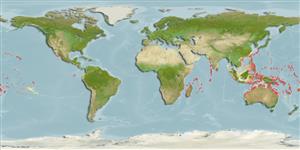Actinopterygii (ray-finned fishes) >
Perciformes (Perch-likes) >
Pomacentridae (Damselfishes) > Pomacentrinae
Etymology: Plectroglyphidodon: Greek,plektron = anything to strike with, spur + Greek, glyphis = carved + Greek, odous = teeth (Ref. 45335). More on author: Fowler.
Environment / Climate / Range
Ecology
Marine; reef-associated; non-migratory; depth range 1 - 18 m (Ref. 1602). Tropical, preferred ?; 30°N - 30°S
Indo-Pacific: East Africa to the Hawaiian, Marquesan, and Pitcairn islands, north to the Ryukyu and Bonin islands, south to Lord Howe Island and Rapa. Unknown from the Red Sea, Persian Gulf and Gulf of Oman (Ref. 11441).
Size / Weight / Age
Maturity: Lm ? range ? - ? cm
Max length : 14.0 cm TL male/unsexed; (Ref. 11441)
Adults are found clear water, inner to outer reef crests in rich coral habitat (Ref. 48636). Benthopelagic (Ref. 58302). Common in passages, frequently associated with Acropora, Stylophora, or Pocillopora coral heads or a single head of Pocillopora eydouxi (= Pocillopora grandis). Usually seen solitary (Ref. 48636). Feed on benthic algae and probably coral polyps. Oviparous, distinct pairing during breeding (Ref. 205). Eggs are demersal and adhere to the substrate (Ref. 205). Males guard and aerate the eggs (Ref. 205).
Life cycle and mating behavior
Maturity | Reproduction | Spawning | Eggs | Fecundity | Larvae
Oviparous, distinct pairing during breeding (Ref. 205). Eggs are demersal and adhere to the substrate (Ref. 205). Males guard and aerate the eggs (Ref. 205).
Allen, G.R., 1991. Damselfishes of the world. Mergus Publishers, Melle, Germany. 271 p. (Ref. 7247)
IUCN Red List Status (Ref. 115185)
CITES (Ref. 94142)
Not Evaluated
Threat to humans
Harmless
Human uses
Fisheries: of no interest; aquarium: commercial
More information
ReferencesAquacultureAquaculture profileStrainsGeneticsAllele frequenciesHeritabilityDiseasesProcessingMass conversion
Tools
Special reports
Download XML
Internet sources
Estimates of some properties based on models
Phylogenetic diversity index (Ref.
82805): PD
50 = 0.5010 [Uniqueness, from 0.5 = low to 2.0 = high].
Bayesian length-weight: a=0.02399 (0.01322 - 0.04352), b=2.95 (2.80 - 3.10), in cm Total Length, based on LWR estimates for this species & (Sub)family-body (Ref.
93245).
Trophic Level (Ref.
69278): 3.4 ±0.6 se; Based on diet studies.
Resilience (Ref.
69278): High, minimum population doubling time less than 15 months (Preliminary K or Fecundity.).
Vulnerability (Ref.
59153): Low to moderate vulnerability (25 of 100) .
